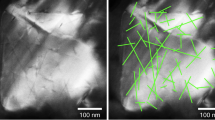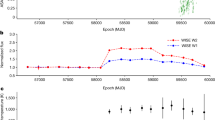Abstract
Dust pervades the Solar System, and is concentrated in the ring systems surrounding the giant planets and along the plane of the planetary orbits (the Zodiacal cloud). Individual dust grains are thought to be generated when impacts loft material from larger bodies20,21,23,24,25,26, 27 such as satellites. Uncertainties in theoretical models of this ejection process are large, and there have hitherto been no direct measurements with which to constrain these models. Here we report in situ measurements of submicrometre dust within a few radii of Jupiter's satellite Ganymede. The directions, speeds and distribution of masses of the grains indicate that they come from Ganymede, and are consistent with an ejection process resulting from hypervelocity impacts of interplanetary dust onto Ganymede's surface. Dust appears also to be concentrated near Callisto and Europa, suggesting that these satellites too are significant sources of dusty debris.
This is a preview of subscription content, access via your institution
Access options
Subscribe to this journal
Receive 51 print issues and online access
$199.00 per year
only $3.90 per issue
Buy this article
- Purchase on Springer Link
- Instant access to full article PDF
Prices may be subject to local taxes which are calculated during checkout



Similar content being viewed by others
References
Grün, E. et al. The Galileo dust detector. Space Sci. Rev. 60, 317–340 (1992).
Grün, E. et al. The Ulysses dust experiment. Astron. Astrophys. Suppl. Ser. 92, 411–423 (1992).
Grün, E. et al. Reduction of Galileo and Ulysses dust data. Planet. Space Sci. 43, 941–951 (1995).
Krüger, H. et al. Three years of Galileo dust data: II. 1993 to 1995. Planet. Space Sci. 47, 85–106 (1999).
Grün, E. et al. Dust measurements in the jovian magnetosphere. Geophys. Res. Lett. 24, 2171–2174 (1997).
Grün, E. et al. Galileo observes electromagnetically coupled dust in the jovian magnetosphere. J.Geophys. Res. 103, 20011–20022 (1998).
Krüger, H., Grün, E., Graps, A. & Lammers, S. Observations of electromagnetically coupled dust in the Jovian magnetosphere. Astrophys. Space Sci.(in the press).
Grün, E. et al. Discovery of jovian dust streams and interstellar grains by the Ulysses spacecraft. Nature 362, 428–430 (1993).
Grün, E. et al. Constraints from Galileo observations on the origin of jovian dust streams. Nature 381, 395–398 (1996).
Krüger, H., Krivov, A. V., Grün, E. & Hamilton, D. P. Adust cloud of Ganymede maintained by hypervelocity impacts of micrometeroids. J. Geophys. Res.(submitted).
Zook, H. A. et al. Solar wind magnetic field bending of jovian dust trajectories. Science 274, 1501–1503 (1996).
Koschny, D. & Grün, E. Impacts into ice-silicate mixtures: Crater morphologies, volumes, depth-to-diameter ratios and yield. Icarus(submitted).
Koschny, D. & Grün, E. Impacts into ice-silicate mixtures: Ejecta mass and size distributions. Icarus(submitted).
Krivov, A. V. On the dust belts of Mars. Astron. Astrophys. 291, 657–663 (1994).
Krivov, A. V. & Jurewicz, A. The ethereal dust envelopes of the Martian moons. Planet. Space Sci. 47, 45–56 (1999).
Iglseder, H., Uesugi, K. & Svedhem, H. Cosmic dust measurements in lunar orbit. Adv. Space Res. 17, 177–182 (1996).
Burns, J. A., Showalter, M. R. & Morfill, G. E. in Planetary Rings(eds Greenberg, R. & Brahic, A.) 200–272 (Univ. Arizona Press, Tucson, (1984).
Ockert-Bell, M. E. et al. The structure of Jupiter's ring system as revealed by the Galileo imaging experiment. Icarus 138, 188–219 (1999).
Burns, J. A. et al. The formation of Jupiter's faint rings. Science 284, 1146–1150 (1999).
Hamilton, D. P. & Burns, J. A. Origin of Saturn's E ring: self-sustained, naturally. Science 264, 550–553 (1994).
Burns, J., Hamilton, D. P., Mignard, F. & Soter, S. in Physics, Chemistry, and Dynamics of Interplanetary Dust(eds Gustafson, B. A. S. & Hanner, M. S.) 179–182 (Vol. 104, ASP Conf. Ser., Kluwer, Dordrecht, (1996).
Banaszkiewicz, M. & Krivov, A. V. Hyperion as a dust source in the saturnian system. Icarus 129, 289–303 (1997).
Esposito, L. W., Brahic, A., Burns, J. A. & Marouf, E. A. in Uranus(eds Bergstrahl, J. T., Miner, E. A. & Matthews, M. S.) 410–465 (Univ. Arizona Press, Tucson, (1991).
Colwell, J. E. & Esposito, L. W. Amodel of dust production in the Neptune ring system. Geophys. Res. Lett. 17, 1741–1744 (1990).
Soter, S. The Dust Belts of Mars(Report of Center for Radiophysics and Space Research No. 462, (1971).
Krivov, A. V. & Hamilton, D. P. Martian dust belts: Waiting for discovery. Icarus 128, 335–353 (1997).
Acknowledgements
We thank the Galileo project at JPL for effective and successful mission operations. A.K. thanks his colleagues in the Heidelberg dust group for their hospitality and for funding his stay at MPIK. This work was supported by Deutsches Zentrum für Luft- und Raumfahrt e.V. (DLR).
Author information
Authors and Affiliations
Corresponding author
Rights and permissions
About this article
Cite this article
Krüger, H., Krivov, A., Hamilton, D. et al. Detection of an impact-generated dust cloud around Ganymede. Nature 399, 558–560 (1999). https://doi.org/10.1038/21136
Received:
Accepted:
Issue Date:
DOI: https://doi.org/10.1038/21136
This article is cited by
-
Review of research on lunar dust dynamics
Astrophysics and Space Science (2022)
-
Science operation plan of Phobos and Deimos from the MMX spacecraft
Earth, Planets and Space (2021)
-
Dust in the Jupiter system outside the rings
Astrodynamics (2019)
-
Circumplanetary Dust Populations
Space Science Reviews (2019)
-
Dust Phenomena Relating to Airless Bodies
Space Science Reviews (2018)
Comments
By submitting a comment you agree to abide by our Terms and Community Guidelines. If you find something abusive or that does not comply with our terms or guidelines please flag it as inappropriate.



